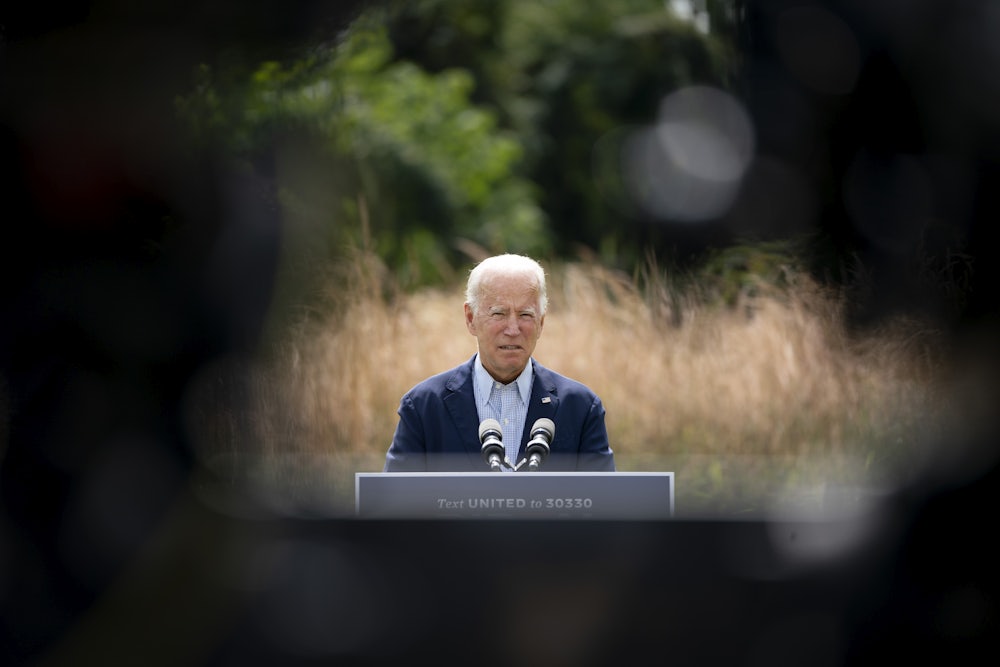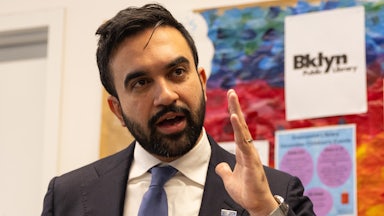The centerpiece of the White House’s climate agenda, the Clean Energy Payment Program, or CEPP, seemingly expired unceremoniously late last week due to West Virginia Senator Joe Manchin’s opposition. Progressives—who’ve watched the reconciliation package be winnowed down from $6 trillion to just $1.9 trillion—are now scrambling to figure out how to bring some kind of comparable emissions-reducing plan back from the dead before world leaders start debating the future of the Paris Agreement in Glasgow on Halloween.
Analyses by Resources for the Future and the research firm Energy Innovation predict that the loss of the CEPP could leave a 20 to 35 percent hole in the emissions reductions that the reconciliation bill once promised. A new Rhodium Group report—reportedly produced in consultation with the White House—says Biden’s goal of reducing greenhouse gas emissions by 50 to 52 percent by 2030 is still within reach even with CEPP off the table, although it would require relying heavily on executive action.
Yet according to reports from negotiations on Tuesday night, Democratic proposals for climate spending in the reconciliation budget have already been whittled down to just $300 billion, or $30 billion a year on average. That’s a far cry from the roughly $1 trillion of annual climate spending experts suggest is necessary to meet the Biden administration’s audacious, Paris Agreement–consistent targets. Before the end of the week, congressional Democrats may broker a deal that will play a major role in determining exactly how close the United States will or won’t come to meeting those emissions targets. Right now, the lawmakers and climate advocates who have been trying to keep the administration on track are worried.
“It’s hard to see how you would achieve the outcomes of Biden’s international climate commitment, [as well as ] to good union jobs and combatting environmental injustice, unless you have investments at the scale that environmental advocates have been pushing for all along,” Ben Beachy, director of the Sierra Club’s Living Economy program, told me over the phone. “Any weakening or removal of CEPP only increases the importance of delivering wholly intact the broad array of climate investments in the Build Back Better Act.”
Joe Manchin’s argument against the program has been that he doesn’t want to pay power companies to do something they were already doing, noting the amount of renewable capacity they have already deployed. But right now, utilities are bringing about 2 percent of new renewable capacity online per year, a rate too slow to meet climate goals. The CEPP would reward utilities that doubled that rate and brought 4 percent more renewable power online each year. It would also punish those that don’t. Manchin opposes this attempt to speed the transition. “The transition’s already happening,” he told CNN, “so I’m not going to sit back and let anyone accelerate whatever the market’s changes are doing.”
The office of Senator Tina Smith, who authored the CEPP, shared that, while the CEPP wasn’t officially dead, talks between Manchin and Smith in recent days hadn’t made his decisive fiftieth vote on the program look any more likely. They added that Smith would be unlikely to support any revisions to the program that would “help develop the construction of new gas plants that will become stranded assets,” by including fossil fuels in its definition of “clean.” Manchin’s staff had floated last month that he might use his Energy and Commerce Committee chairmanship to alter the proposal along those lines.
“From the beginning, I’ve said that climate action is one of the most critical parts of this bill. It’s at the heart of progressive support for the Build Back Better agenda. This legislation must advance our goal of tackling the climate crisis by cutting greenhouse gas emissions by at least 50 percent by 2030 and creating jobs,” Representative Ro Khanna said over email. “While CEPP is the most proven, effective way, if there are other options for achieving this, I am open to it. We have a once-in-a-generation chance to address the global climate emergency. We’re not going to stop fighting until we have assurance that bold action on climate is included.”
The other landmark climate provision still included in the bill is an expansion of investment and production tax credits for solar and wind power, respectively. The Energy Innovation analysis, like others, envisions these doing the majority of the work of emissions reduction, albeit much less so without the CEPP to complement that work. Tax credits, CEPP author Smith told CNN this week, “will be a very important part of our solution, but I don’t think they will be enough.”
And how much slack the tax credits can pick up depends heavily on both how big they are and how they’re structured. These subsidies currently exclude public utilities that lack the tax liability necessary to take advantage of them. Utilities under this category serve roughly a third of all U.S. power customers. Without being accessible to municipal utilities and coops—which have billions of dollars of debt bound up in coal plants—there’s a ceiling on how effective even beefed-up tax credits will be. Even major wind and solar developers have had trouble taking advantage of them and typically need to form partnerships that enter into shadowy agreements with tax equity investors housed largely in major Wall Street banks. The “expectation” in Smith’s office was that tax credits would indeed be refundable and allow public utilities to take advantage of them, correcting for the well-known issues in the current program. There are many different types of clean energy tax credits, though. Some, like the section 25D tax credit for residential solar, are still non-refundable in recent versions of the reconciliation package, according to sources familiar with negotiations. Whether another proposed investment tax credit for transmission lines would be refundable remains unclear, as well.
“Tax credits alone are not going to cut it,” Sunrise Movement advocacy director Lauren Maunus told me over the phone. In line with other progressives, her group is advocating to redistribute the $150 billion previously earmarked for the CEPP to other climate-related programs, including to bring new renewables online and retrofit public schools and housing. “We can’t let up on the robust direct investments to reach the emissions reductions goals,” she said.
Without naming specifics, Maunus also voiced frustration with how other groups in the climate space have navigated in Washington the last several months. “We’ve always been in the camp of needing to demand what we actually need, and what the climate and justice requires,” she said. “That’s the mandate that Biden and the House and Senate were elected on. Therefore we’ve been pushing for the most ambitious version of transitioning the power sector. Other organizations have taken a, ‘Let’s see what we can pass by Manchin’ strategy, starting from the lowest common denominator.”
Progressives are specifically concerned with how to transition electricity off fossil fuels, which other line items tackle much less directly than the CEPP. Cleaning up the U.S. power sector is an essential piece of the climate equation, given that it’s the second-largest source of emissions here, after transportation. It’s also quite literally the infrastructure of decarbonization: The grid will have to expand rapidly as more and more activities—like home heating and transportation—come to rely on electricity rather than fossil fuels, and transform both to distribute and take in electricity from distributed renewable generation. The stock of things to decarbonize should get bigger every year. And all the power for them needs to be coming from zero-carbon sources; 60 percent of electricity now comes from fossil fuels.
“There is $150 billion that was allotted to decarbonization of the electrical sector in the reconciliation bill, and we need to do all we can to look for ways to still use that money to decarbonize the electrical sector,” said Jamal Raad, the executive director of Evergreen Action, a think tank formed out of Jay Inslee’s climate-focused presidential campaign that worked closely with lawmakers on the CEPP.
One proposal circulating among progressive groups would try to replicate the carrot approach taken by the CEPP, by allocating $50 billion in “energy challenge grants” to states that implement their own clean electricity standards. According to a one-page summary provided to TNR, those grants “would be technology-neutral and flexible. Each state could present a plan that fits with its own preferred technology mix, policy approach, and timeline.” Funding could “be used to lower customer electricity bills, to keep the cost of power affordable for everyday Americans.” New Mexico Senator Ben Ray Luján suggested there could also be a way for the federal government to invest in transmission systems for states, rural cooperatives, and public utilities that pledge to enact clean electricity standards and reduce emissions.
The White House faces two separate deadlines. One is further off: keeping Biden’s pledge to lower U.S. emissions between 50 and 52 percent below 2005 levels by 2030. The other is quite urgent: not showing up empty-handed to COP 26, the U.N. climate talks where Biden will arrive on November 1 for the World Leaders Summit. It would be embarrassing, bordering on self-sabotage, for a country that has spent months lecturing the rest of the world to ramp up its commitments under the Paris Agreement to arrive without much more than an IOU. “By the time Glasgow’s over,” climate envoy John Kerry said last week, “we’re going to know who is doing their fair share, and who isn’t.”
To clarify, the Biden administration’s definition of what constitutes its fair share of emissions reductions is a good deal lower than what the Climate Equity Reference Project and the U.S. Climate Action Network—composed of more than 185 organizations and a longtime participant in U.N. climate talks—have calculated. Owing to America’s outsize historical responsibility for the climate crisis, truly doing its “fair share” would, according to their analysis, require the U.S. to cut emissions by 70 percent below 2005 levels by 2030, or five billion tons of carbon dioxide, and furnishing financing to make an additional six billion tons of emissions possible in developing countries. This level of “fair share” isn’t close to being on the table for either the White House or Congress.
With fewer than 10 days to go before Biden touches down in Glasgow, one of the major divides among Democrats now is what the division of labor should be between legislation and executive authority, including agency rulemaking and executive orders. While there’s general consensus that both are necessary, some fear that pivoting too quickly toward the latter could relieve pressure on Congress to get as much as it can out of regulations. In line with the Rhodium Group analysis, the White House earlier this week signaled it would double down on executive authority, having that play a bigger role than it might in the event of a more clear congressional victory. The Environmental Protection Agency is expected to announce new rules to rein in methane emissions, and the Treasury Department is set to unveil a slate of new policies for addressing climate risks in the financial sector, undoubtedly with an eye toward Glasgow.
Tyson Slocum, director of the nonprofit Public Citizen’s Energy Program, sounded less apocalyptic than many of the green group staffers I spoke with. “Anyone saying the death of [the CEPP] is a huge blow to the climate movement needs to take a deep breath and understand that this isn’t the end of it,” he told me. “The climate tools in this reconciliation package were not designed for maximum effectiveness. They were designed to fit within bizarre and arcane parliamentary budget rules. This isn’t the optimal program that we wanted anyway.”
Regulatory tools, Slocum said, “should be at the forefront of Biden’s arsenal.… I don’t understand why the admin isn’t leading with, ‘Look Manchin, you can sit here and dither and hold things up. I don’t care because my EPA is ordered by the Supreme Court to regulate carbon dioxide. We can replicate what you’re blocking legislatively.” Such regulations are vulnerable to court challenges like the ones that tied up the Obama administration’s Clean Power Plan. But with Congress unlikely to pass a climate law anytime soon, Slocum doesn’t want to see the EPA’s considerable emissions-cutting authority left on the table. “Joe Manchin is an obstructionist, and he is unnecessarily getting in the way of progress. But we’ve got other tools and other avenues to accomplish things.”
There are still plenty of emissions reductions up for grabs that the administration hasn’t touched and that don’t appear in the Rhodium Group’s survey of potential executive branch action. The statute that repealed the long-standing crude oil export ban in 2015 allows the president to submit an emergency declaration to suspend or curtail those exports for a year, that he can renew annually. The Department of Energy could reduce levels of liquefied natural gas exports. The Federal Energy Regulatory Commission has broad control over natural gas markets and could take on price gouging and “try to address the real problem of energy burdens and access to energy that millions and millions of Americans are experiencing right now,” Slocum said. A recent report from Oil Change International finds that the administration stopping just 24 proposed oil and gas projects could prevent polluters from emitting the equivalent of 20 percent of America’s entire greenhouse gas emissions in 2019. Doing so would require the White House to do something it hasn’t been willing to so far: challenge fossil fuel production.
The 2021 Production Gap Report released this week by the U.N. Environment Program, Stockholm Environmental Institute, and several other research outfits underlined the need to do just that, bolstering demands from the Indigenous leaders who converged on Washington, D.C., last week under the banner of People vs. Fossil Fuels. The report finds that world governments are still on track to produce more than double the amount of fossil fuels in 2030 than is consistent with limiting global warming to 1.5 degrees Celsius (2.7 degrees Fahrenheit), a goal to which the Biden administration—despite its reticence to reject low-hanging carboniferous fruit like the Line 3 pipeline—still claims to be committed.
Besides showing up to COP 26 with peanuts, Democrats risk entering into the 2022 midterms without much to show for themselves, climate-related or otherwise. Faced with the much lower top-line numbers imposed by Manchin, Kyrsten Sinema, and their donors, different program areas are fighting for space in the reconciliation package. It now looks like the administration is opting for more across-the-board cuts that lean toward making more programs smaller and temporary rather than cutting whole buckets of funds altogether. “There’s just general downward pressure on everyone’s numbers,” Raad said, “and talk of doing all the programs and shrinking the years on them. But that doesn’t work for climate provisions. We need the investment through the 10-year window to allow folks to make business decisions through the decade. Having these investments depend on whether Donald Trump becomes president again is too much of a risk for a lot of investors and businesses.”
These kinds of haircuts could leave bread-and-butter social programs—the kind that might have encouraged voters to come to the polls for Democrats, like the child tax credit—making a more muted impact on people’s lives. And while green groups have been advertising the jobs benefits of clean energy and climate programs, it’s still not clear how concretely voters will connect clean energy tax credits, for instance, to quality of life improvements—or if the White House will adjust its own message to make that clear. Yet with such limited prospects for climate action from Congress, Biden will need to find some way of buying Democrats more seats and time to have any shot at living up to the claims of U.S. climate leadership he’ll bring to the U.N. climate talks at month’s end.








